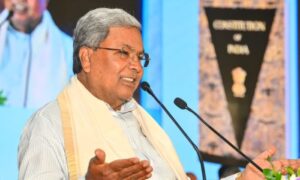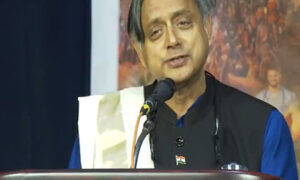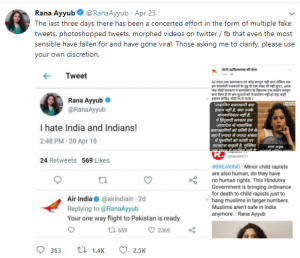
Source: Screengrab from Rana Aayub’s Twitter Handle
“The last three days there has been a concerted effort in the form of multiple fake tweets, photoshopped tweets, morphed videos on twitter / fb that even the most sensible have fallen for and have gone viral. Those asking me to clarify, please use your own discretion” recently tweeted by Rana Aayub –a journalist who wrote a very critical book titled Gujarat Files. Rana is well-known for her political commentaries which grab attention from various political hues.
International Women’s Media Foundation (IWMF) condemned the online attack. Its release stated, “Harassment in journalism and the media industry has risen to the forefront of public attention. The online world is where journalists experience most threats. When journalists are targets of online abuse, the attacks take a toll on freedom of expression and freedom of the press. The chilling effect on individual journalists and journalistic lines of inquiry can lead to the silencing of diverse voices in the media.”
It is not an isolated story. Fake news is an apparent trend. With increasing usages of the internet and smartphones, the fake news industry is thriving which is a global phenomenon. Its scope is very wide. One can use fake news against any government, any person, any community, any political party and any organisation to malign their reputation in order to gain benefit tangible or intangible. It is adequately documented that India is an extremely diverse country where several warring groups are engaging various kinds of nefarious activities. There are various tools of fake news: fake posts, fake tweets, morphed photos & videos. The vested interest groups are circulating such kinds of stuff. Increasing aspirations and reducing internet prices are creating a favourable situation for it. There is no mechanism for verification and multiple fake accounts are engaging in likes, share, and comments. It is becoming an industry where “likes” and “share” are paid. Fake news is not a new phenomenon. In news media, there was a scope of planting stories against rivals. Influential people used it as a tool to malign their opponents. Vested interest groups pitched and planted fabricated stories against any schemes or interventions. The social media has widened its horizon. The 2016 US Presidential Election contributed a lot to Fake Newsdocumentedeted by various sources.
In this backdrop, the Ministry of Information and Broadcasting (I&B) released a circular to deal with the fake news. The I&B directive triggered an uproar in News Media Industry(Circular isuploaded). After the intervention of the Prime Minister Office (PMO), I&B Ministry withdrew the circular. The entire episode embarrassed the I&B ministry. The news media mainly print and electronic fraternity vehemently criticised such approach. The directive was prepared in the haste. Such decisions require deliberation and public reasoning. The engagement of multiple stakeholders is highly required if the government is serious about taming the fake news.
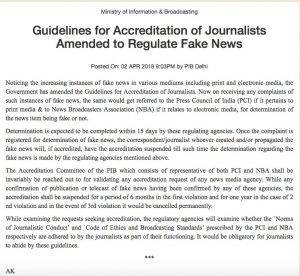
It is widely reported that Facebook was engaged in the peddling of fake news. After a severe allegation of fake news and privacy breaches, Mark Zuckerberg was grilled in the US Parliament in April because Congress wanted him to testify. It was reported that Facebook announced that the social network is alerting news feed algorithm so that users will see less content from the sensation-seeking publishers and websites.
It’s worthwhile to mention that the main carrier of the fake news is the social media which can create havoc. The companies like Facebook and Twitter are behemoths. The decision makers across the globe including India loved to engage them and posed themselves in front of cameras whenever the top executives met.
At this juncture, S. Rajaratnam School of International Studies, (RSIS), Nanyang Technological University prepared a policy report titled Countering Fake News. The policy report showed that what kinds of the steps the governments are taking to counter the menace of fake news. As report showed, various factors are motivating the governments’ steps. It stated that a multi-pronged strategy that comprises both legislation and non-legislative measures is needed. Few countries enacted the law to deal with fake news and new laws are being proposed in some other countries. There is a growing fear that the government can bend the law in order to sabotage the opposition.
The above-mentioned report summarised the fake news legislation worldwide as at January 2018. It’s very relevant for a country like India.
Fake News Legislation Worldwide

Source: Policy Report: Countering Fake News: A Survey of Recent Global Initiatives
The report stated, “The impact of fake news is amplified through (i) internet platforms, which publish content with significantly lower cost, wider reach and rapid circulation; (ii) social media, which enables more people and groups of various persuasions to interact even as they consume, produce and re-circulate content; and (iii) artificial intelligence (AI) agents that automate the work of human propagators.
Combatting Fake News:
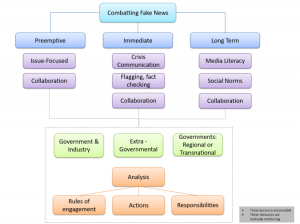
Source: Policy Report: Countering Fake News: A Survey of Recent Global Initiatives
In a path-breaking account on fake news, Sharyl Attkisson her wrote in the book The Smear, “We didn’t get here overnight. The past two decades have served as an ideal incubator for an industry of smears and fake news. The tools and tactics have evolved from old-school to high-tech. Incredible amounts of money change hands, yet some of the most damaging smears can be accomplished with little more than an idea and an Internet connection. By 2016, a Pew Research Center report found more than 44 percent of the American adult population got its news on Facebook, which had 1.09 billion active daily users. Some of that news is true. Some of it’s not. Today, an entire movement can be started with a few bogus Twitter accounts and 140 characters or less.”
Attkisson further added, “You don’t have to spend millions on political ad buys anymore,” observes one operative in the business. “You can spark wildfires with just a tiny little stick now, which is a new thing.”


